Firmness First!
Brace yourselves ... because we have got some work to do!
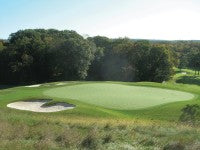 To get our greens properly into shape we all have to knuckle down. The game of golf depends on it. Our greens need to be firmer to be true to the game and to provide better year-round performance. Put debates about cutting heights and sustainability aside for a moment because this is more important. The game of golf is in danger of being "dumbed down" with soft putting surfaces. This is what we found.
To get our greens properly into shape we all have to knuckle down. The game of golf depends on it. Our greens need to be firmer to be true to the game and to provide better year-round performance. Put debates about cutting heights and sustainability aside for a moment because this is more important. The game of golf is in danger of being "dumbed down" with soft putting surfaces. This is what we found.
During our 2009 agronomy visits, we conducted a pilot study for what has now become The STRI Programme. The aim of this study was to pioneer a new style of agronomy that removes the element of subjectivity or personal opinion from the assessment of the greens. During these pilot study visits, we measured both the performance and condition of the greens. This included the playing qualities (speed, smoothness and firmness) as well as the key agronomic factors that influence them (soil organic matter and moisture content).
We found that this new approach provided a more complete assessment of each green, and it also gave a measure of the level of consistency being achieved. The measurements not only gave us a better understanding of the situation, they also allowed us to work towards specific targets to bring about improvement. Participating clients welcomed this new approach because it really clarified the situation and helped them plan the way ahead. The pilot study was successful and we launched The STRI Programme as a new service in January 2010.
At the end of 2009, we then took the time to analyse the data we had collected throughout the year. We did this to help shed light on the wider situation and help us understand how successful we were being. The results were very interesting, especially when it came to the firmness figures.
You'll see from the results that it appears we might be going soft in our old age! At a time when we should be challenging the modern golfer to strike the ball correctly on approach to the green, it seems that we might be flattering them with softer "target-style" greens that will accept any shot, no matter how well (or not) it is struck. Surely, the highest aim of our modern greenkeeping must be to reward good clean ball striking rather than flattering average play.
From our results it appears that we might be taking our eye off the ball by concentrating too much on the roll of the ball. Upon reflection, we think that it is time for us all to get a grip on the game again and test all aspects of play. Golf greens should be firm to test ball striking and, so, surface firmness is where we will start our final stand.
If you wanted the truth, then this is it
Our ultimate aim is to create a consistent set of well-paced, smooth and true surfaces for putting that also receive, hold and then release well-struck approach shots. We want to reward good approach play with greens that receive a well-struck ball but discard loose and inaccurate play. Fair enough.
Consistency of firmness is also important, and we must work to achieve surfaces that don't fluctuate too much throughout the year. Essentially, for optimal performance, we want the greens to retain the desired level of firmness in both wet and dry conditions. So, what exactly is the desired level of firmness for golf greens?
STRI Research
The last major study on the playing performance of UK golf greens was carried out by STRI in 1996 (Baker et al) with the aid of funding from The R&A. This study involved the assessment of the playing qualities of greens (speed, smoothness, firmness etc.) from a range of course types situated throughout the UK. The survey also measured the key agronomic factors that affected playing quality, as well as canvassing player perception about the green performance. In total, seventy-four courses were visited and three greens were tested on each course.
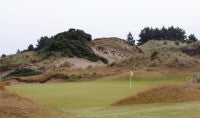
Surface firmness was measured using the Clegg Impact Hammer, and the results were correlated against ball impact behaviour and player perception. At Clegg values beneath 76* gravities the players perceived the surfaces to be too soft. As Clegg values increased, the ball stopping distance from simulated 5-iron and 9-iron shots also increased.
The study concluded that Clegg values of between 76-125* gravities were acceptable for play, with the top end of the scale being deemed to provide fair but challenging surfaces.
Measuring Firmness
During our pilot study inspections in 2009, we measured the surface firmness using a new golf specific version of the Clegg Impact Hammer (with 0.5kg rounded head test mass dropped from 0.5m). The moisture content of the upper soil profile was also measured to contextualise the results.
For both tests a 9-point sampling grid was employed (left-middle-right from front-middle-back) and an average (mean) was calculated for each green. By using these standardised sampling protocols our aim was to provide an accurate assessment of the situation and produce results that could be compared against our targets.
Setting Targets
During our visits we would take the readings, calculate the results and then discuss their meaning with our clients. Our aim was for everyone to understand the situation fully before we formulated our maintenance plan. We set our firmness targets depending on the style of the course, with reference to the research data from 1996 and also from our experiences during the pilot study itself.
Remember that our aim is to provide challenging surfaces that perform well throughout the year. For simplicities sake, the table above describes what the Clegg readings mean and shows our target ranges for parkland and links style courses.
In general terms, for parkland courses we were looking to achieve Clegg values of 80-100 gravities through the main playing season and, for the links, a firmer 100-130 would be more appropriate. The target for authentic heathland might be 90-110.
During the winter, or through extended periods of wet weather, we would be working to stay within these ranges if possible.
The targets we set always reflect the specific demands of the course and they seek to optimise performance at all times. Clegg readings towards the higher end of each range would provide a more demanding (or less forgiving) surface. So, that is what we are aiming to achieve, but what did we actually find in 2009?
The 2009 Firmness Results
The following results were obtained during 2009 (May - October). We gathered data from approximately 600 greens from 110 courses, making it one of the biggest studies of UK golf greens ever carried out. The results were obtained for courses in our areas in the North/East of England and Central/Eastern Scotland.
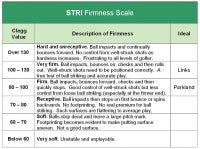
In general, we took readings from three greens on each course to represent the range of standards being set, but we sometimes took more measurements to help build a complete picture of the situation. We feel that the sample size and sampling method we used gave a good overall representation of the standards being set in our area last year.
The majority of the course types were either parkland or links and there were approximately 300 results for each. The following charts show the firmness figures being achieved for each style of course.
Parkland results
The table shows the firmness results that we obtained from parkland greens.
So, for parkland courses, only 50% of the results fell within the optimal performance range of 80-100 gravities (of which two-thirds were in the softer 80-90 end). Such surfaces are firm underfoot and receive well-struck balls with a bounce forward and then a check to stop.
This type of surface is ideal for a parkland setting and provides good control of well-struck shots, but offers less control for poorer ball striking. Perfect.
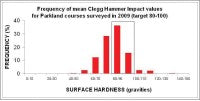
Our advice for greens in this range would have been focused on the ways to keep them here for as long as possible in the year. We would be targeting specific levels of organic matter content in the upper soil profile and would be communicating the need for essential (and possibly unpopular) maintenance work to achieve them. In this range we are happy with the standard being set, but are not complacent or self congratulatory.
Nearly 50% of our parkland greens, however, were softer than the optimal range. A quarter of all the results were in the "receptive" range (70-80 gravities). Here, the surfaces tend to receive and hold the majority of approach shots, and offer no real premium on good ball striking, so make them flattering for average play.
A further 12.5% of the parkland results were softer still, being within the "soft" range (60-70 gravities). These greens stop a ball dead and it will leave a large pitch mark. Such soft surfaces become damaged with pitchmarks, and they footprint under play to make the putting surface uneven. Around 5% of the parkland greens we measured were below 60 or "very soft" and unstable/unplayable.
So, a significant proportion of the all parkland greens we measured during the 2009 playing season were too soft. Our advice for these greens would have been focused on firming them up. The soil moisture and organic matter content measurements will have completed the picture and helped focus this work properly.
We will have discussed improving the drainage and reducing the influence of the organic matter content of the upper soil profile with aeration and top dressing. Specific targets would certainly have been set for the organic matter levels.
All elements of the maintenance strategy will have been addressed to bring about the desired improvement in firmness. Again, we will have been clarifying the need for essential maintenance work and the importance of timing it correctly. We always need permission to make headway.
It is true to say that the main cause of soft greens stems from the general reluctance of the golfers to allow us to carry out any disruptive work, such as hollow tining to reduce thatch levels. Poor green performance is usually the result of restricting the maintenance programme to suit the golfers, rather than being an indication of bad greenkeeping/agronomy.
To highlight this issue we found that, where organic matter content (% by loss on ignition), was within our target range (less than 6% in the top 20mm and less than 4% between 20-40mm) the mean Clegg value was 88 and situated in the middle of our target range. However, when the organic matter content was higher than our target range, then the mean Clegg value was lower (80 gravities) and barely within our desired performance range.
This information helps committees, and indeed members, to understand the reason why we need to reduce soil organic matter levels and so give us permission to proceed. An objective approach that explains the situation clearly is beneficial for us all.
Links results
The table shows the firmness results that we obtained from links greens.
The links greens were firmer than the parkland greens but, when compared to their own target range, we found a similar situation. In our study, only 50% of the greens were found to be within their optimal firmness range of 100-130 gravities. These ideal links greens were providing very firm surfaces where the well-struck ball impacts, bounces on, checks and then rolls out. Links greens in such optimal condition provide a true test of ball striking and shot accuracy, with the spill-offs waiting to feed away any loose or inaccurate play.
Clients who had greens within this range would be receiving advice focused on pushing them towards the firmer end. Organic matter content, sward composition, topdressing (type, amount and frequency), aeration, nutrition and water management would have all been discussed, and a plan formulated to maintain this optimal level of performance. You might say that these greens were the "real McCoy".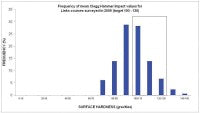
Again, nearly half of all the links greens we measured were softer than the desired range. 40% of all the links readings were between 80-100 gravities, which are "firm" (and good for a parkland situation) but they are not really firm enough for the demanding links, where we want the ball to release out after impact.
Another 5% were inappropriately "receptive" (readings between 70-80 gravities) to create a surface where the ball impacts and then stops on first bounce, or even spins backwards! There might not be any footprinting on these greens but there isn't any premium on ball striking either. Such greens are flattering to average play rather than being the true test of golf. Our discussions and recommendations for these greens would have centred on the best methods to firm them up, i.e. soil amendment, organic matter reduction, irrigation strategy etc.
We improve these greens with good solid greenkeeping that is targeted on achieving our specific and measurable targets. We know the answers.
The Reason
By far the most interesting result we found in our data was the relationship between moisture content and Clegg values (firmness). This will, hopefully, crystallise your understanding of surface firmness for you.
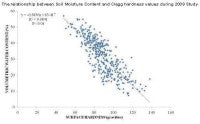 The graph represents all the readings that we obtained in 2009. These results include all the different course types, construction methods, grass types, organic matter contents etc.
The graph represents all the readings that we obtained in 2009. These results include all the different course types, construction methods, grass types, organic matter contents etc.
Even with such a high level of potential variation, the relationship between moisture content and Clegg values was still strong. This means that the firmness of the surfaces largely depends on the soil moisture content. Wet soils create softer surfaces than dry ones. Get it.
If we could manage our soil moisture content between 20% and 30%, then we would generally be within our firmness target ranges. We should certainly be using moisture meters to guide irrigation strategy. Unfortunately, in the North of England and Scotland we can't control the rain, so we also need to work at making the upper soil profile less moisture retentive.
This is why we focus on drainage, construction method, wetting agent strategy, ameliorating the rootzone with specific sands and managing the soil organic matter content. If we set solid foundations, then the greens will be less moisture retentive and the surfaces will be less prone to softening when wet. We achieve optimal year-round performance by creating soils that do not retain moisture. Simple stuff.
No wonder
During the course of our pilot study for the STRI Programme, we found that a significant proportion of our surfaces were too soft. At best, these surfaces were flattering to average play and, at worst, they are not really acceptable for play.
It is clear that we need to work at creating surfaces that are firm enough to be true to the game, and maintain performance throughout the year. Your course needs firm greens. We don't think that this situation is anyone's intention. We think that this has happened because we haven't been working towards specific targets. We think that, by using objective measurement tools to assess the situation, we can focus our work properly and provide simple targets to make the greens firmer and perform better. We think that our greenkeepers will improve the performance of the greens by simply being advised of the situation correctly.
We know that the game of golf is going to get better once it is back in the hands of properly focused greenkeepers. This is why the STRI Programme has been developed. If you want your greens to provide an optimum test of golf and perform well throughout the year, then set your sights on firmness first.
*Figures converted from the Clegg used with 0.5kg flat head, dropped from 0.3m, as used in the 1996 study into equivalent figures for 0.5kg rounded head, dropped from 0.50m, now being used.
